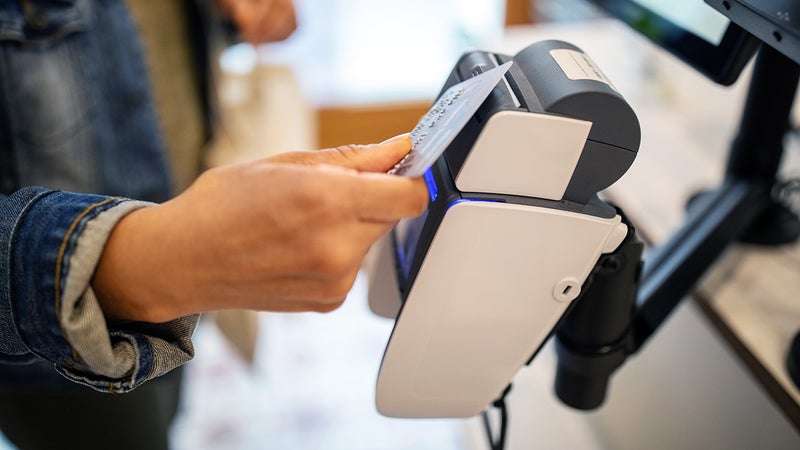Battle of secured credit cards: One card that reigns supreme

The Bankrate promise
At Bankrate we strive to help you make smarter financial decisions. While we adhere to strict , this post may contain references to products from our partners. Here's an explanation for . The content on this page is accurate as of the posting date; however, some of the offers mentioned may have expired. Terms apply to the offers listed on this page. Any opinions, analyses, reviews or recommendations expressed in this article are those of the author’s alone, and have not been reviewed, approved or otherwise endorsed by any card issuer.
Secured credit cards might not get as much attention as lucrative rewards credit cards, but they play a crucial role in the world of credit cards — offering credit to those with lower credit scores or no credit history. If your credit could use some work, you shouldn’t settle for just any secured card. Like any category of credit cards, secured credit cards aren’t created equal.
In this battle of secured credit cards, we’ll look at some of the best secured credit cards on the market and compare them to find the winner.
Let the battle begin.
Picking contenders for the battle of secured credit cards
Not all secured credit cards have made it to our battle. That doesn’t mean there’s something wrong with them. For instance, the Capital One Platinum Secured Credit Card is a solid secured card that can help a cardholder create a relationship with one of the top card issuers, and the same applies to the Citi® Secured Mastercard®.
However, the credit card market is becoming more and more competitive. Today, many top secured credit cards offer rewards — and these are the credit cards that we’ll take a look at. After all, why solely build credit when you can build credit and earn cash back?
It’s also important to mention that all of the secured credit cards competing in our battle don’t charge annual fees (and we recommend staying away from secured cards that do). Plus, our contenders all offer free credit-tracking tools to help you monitor your progress.
Without further ado, here are our contenders: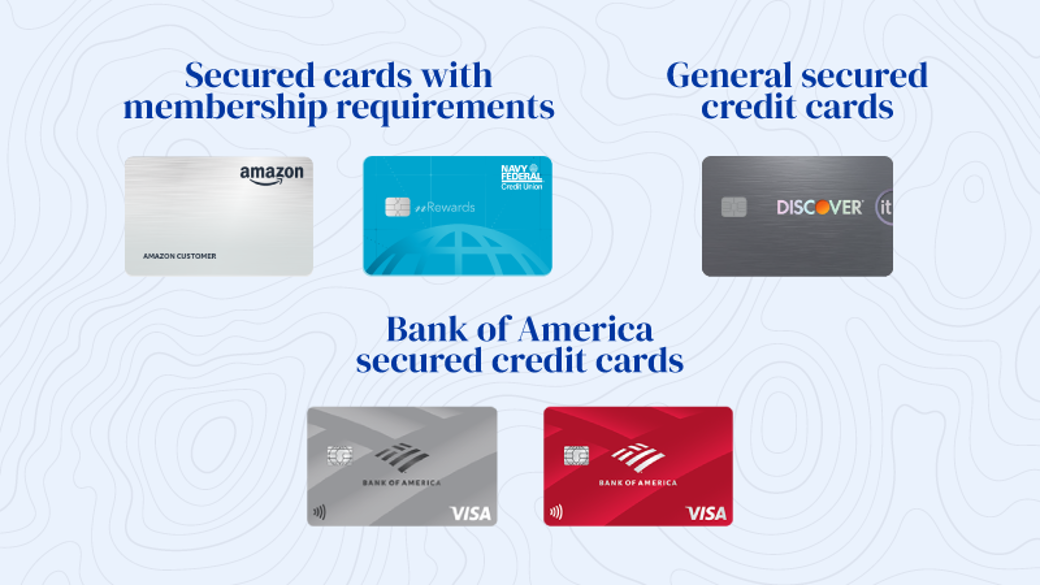
First round: Amazon Prime Secured Card vs. Navy Federal Credit Union nRewards Secured Card
In the first round, we’re going to take a look at two secured cards that offer rewards but come with certain requirements or limitations, such as membership requirements or limited card acceptance. The Amazon Prime Secured Card and the Navy Federal Credit Union nRewards® Secured Card both offer rewards and require a membership to be eligible to apply.
The Navy Federal Secured card earns 1X points on all purchases and rewards can be redeemed for cash back, merchandise or gift cards. The card requires a minimum deposit of at least $200, which then serves as your credit line. The credit union will review your account for a higher credit limit after three months with the card, and it’ll consider an upgrade to an unsecured credit card after six months. There’s no annual fee, and other common credit card fees are quite low: The card only charges up to $20 in late or returned payment fees.
All of this is great news for credit builders. There’s only one catch: You’ll need a Navy Federal Credit Union membership to apply for this card. Unlike some other credit unions, Navy Federal doesn’t offer an option to make a small donation to become a member. To be eligible for a membership, you must be a current or retired armed forces member or have one in your immediate family. Membership is also available to Department of Defense civilian employees.
The Amazon Prime Secured Card also requires a membership to earn rewards. This membership, however, is much more accessible — the card earns 2 percent back on all Amazon purchases if you’re an Amazon Prime member. It’s also a very affordable card. The minimum security deposit must be at least $100. There’s also no annual fee (but you’ll need to pay for a $139 Amazon Prime membership) and the late fee is only $5.
On top of those benefits, the regular fixed APR is just 10 percent, meaning it doesn’t change based on the prime rate, which is a rare feature. As for graduating to an unsecured card, you may become eligible for the unsecured Amazon Store Card* or Amazon Prime Store Card* after 12 months of responsible card use and credit building.
The only caveat is that you can only use the Amazon Prime Secured Card at Amazon.com and physical Amazon stores. That’s rather limiting, but luckily, Amazon sells just about everything. For that reason, we’re giving this round to the Amazon Prime Secured Card. Overall, the Amazon Prime Secured Card is much more accessible and offers great value, but if you’re able to qualify for the Navy Federal Secured card, that’s still an excellent option.
First-round winner: Amazon Prime Secured Card
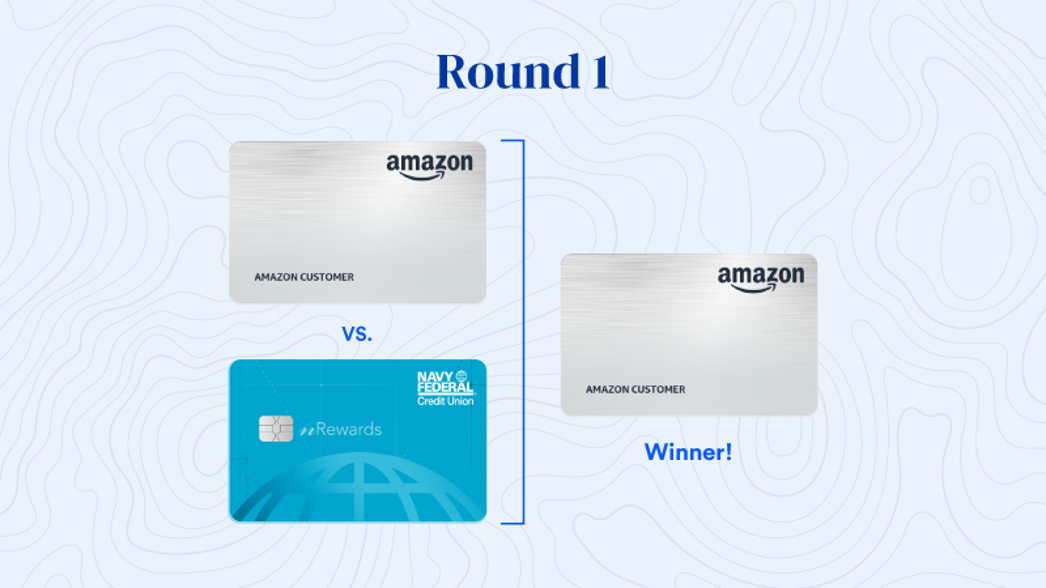
Qualifier: Bank of America Customized Cash Rewards Secured vs. Bank of America Unlimited Cash Rewards Secured
Bank of America currently offers three secured credit cards, but only two have made it to our battle since they offer rewards — the Bank of America® Customized Cash Rewards Secured Credit Card* and the Bank of America® Unlimited Cash Rewards Secured credit card*. Now, it’s time to set these two contenders against each other to pick one to compete in the second round. Both of these cards are secured versions of unsecured Bank of America credit cards with identical rewards systems.
The Customized Cash Rewards Secured earns 3 percent cash back in the category of your choice (choose from gas, online shopping, dining, travel, drugstores or home improvement) and 2 percent cash back at grocery stores and wholesale clubs. All other purchases earn 1 percent back. Note that 3 percent and 2 percent categories are limited to the first $2,500 in combined spending per quarter. The rewards structure on the Unlimited Cash Rewards Secured is much simpler: You’ll earn 1.5 percent cash back on all purchases.
The cards share similar terms, however. The minimum security deposit is $300, and Bank of America will periodically review your account to determine whether you may qualify to have it returned. The variable APRs are the same at 23.99 percent, and both cards offer similar benefits, like access to your FICO score. The difference then lies in the value these cards provide.
Consider this scenario: Say you spend $15,900 per year on the Customized Cash Rewards Secured, which we consider the average annual credit card spend. You make a point to use the 3 percent category for dining and the 2 percent category for grocery stores. You spend $3,600 on dining and $4,700 on groceries annually. You’ll then earn $108 back in the 3 percent category, $94 in the 2 percent category and $76 in rewards on the rest of your spending ($7,600).
All in all, you’ll earn $278 in cash back per year — even without working to maximize the 3 percent and 2 percent cash back categories. With the Unlimited Cash Rewards Secured and the same $15,900 spend, you’d earn $239 in rewards per year. We have a clear winner: the Bank of America Customized Cash Rewards Secured.
Qualifier winner: Bank of America Customized Cash Rewards Secured
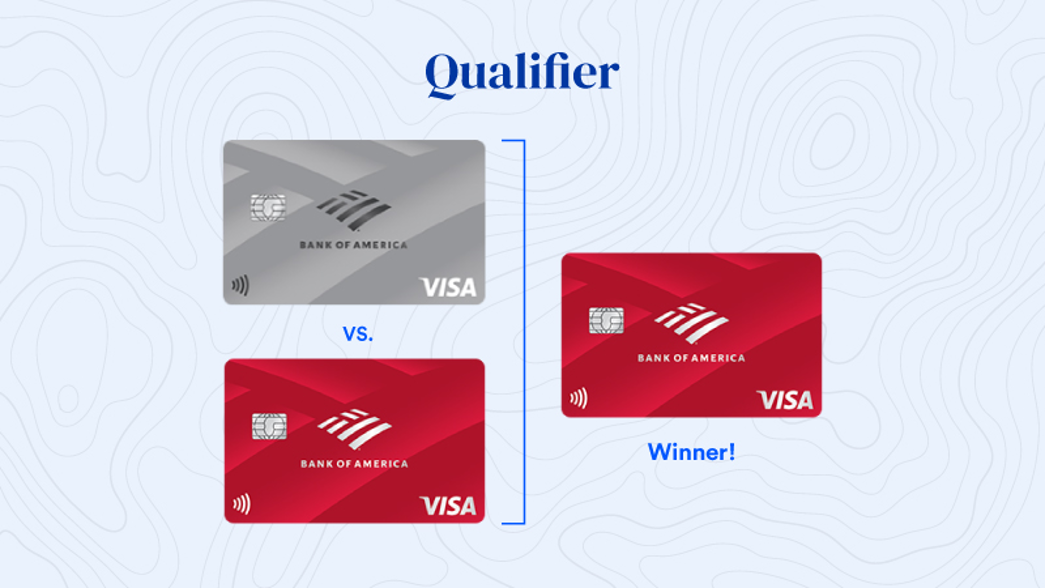
Second round: Discover it® Secured Credit Card vs. Bank of America Customized Cash Rewards Secured
Now that we have a contender from Bank of America — the Bank of America Customized Cash Rewards Secured — we can set it against the Discover it® Secured Credit Card, a secured card that’s long been considered the best offer in the secured card space. But will the Discover it® Secured Credit Card hold its top spot? Let’s find out.
The Discover it Secured Credit Card reigns supreme in the secured credit card market. For a while, it was the only general secured credit card from a top issuer that offered rewards: It offers 2 percent cash back at gas stations and restaurants (on up to $1,000 in combined purchases per quarter, then 1 percent back) and 1 percent cash back on everything else. Additionally, like other top rewards cards from Discover, the Discover it Secured Credit Card matches all the cash back you earn during the first year.
To open the card, you’ll need to put down a security deposit of at least $200 (maximum of $2,500). Then, Discover will review your account after seven months with the card to determine if you qualify for an upgrade to an unsecured card. The Discover it® Secured Credit Card also doesn’t charge an annual fee and it “forgives” cardholders for the first late payment (then up to $41). On top of that, the card comes with a low intro APR of 10.99 percent on balance transfers for the first six months (27.49 percent variable after that), which is a great offer if you want to transfer a balance from a higher-interest card.
As far as secured cards go, the Discover it® Secured Credit Card has been, historically, hard to compete with — until Bank of America’s secured cards entered the ring. As you can see, the Discover it Secured offers some notable perks that the Bank of America Customized Cash Rewards Secured doesn’t. Now, let’s get to the important part: their value.
Let’s take the same scenario as before with $15,900 in annual spend, which includes $3,600 on dining and $4,700 on groceries annually. As you’ll remember, we got $278 in annual cash back with the Bank of America Customized Cash. With the Discover it® Secured Credit Card, you’ll easily maximize the 2 percent category due to the low quarterly spend cap ($1,000).
Using our previous figures, if you spend $3,600 on restaurants annually (and no more than $1,000 per quarter), you’ll earn $72 in cash back on those purchases. You’ll also earn 1 percent back on groceries, or $47 in rewards, and $76 on the rest of your spending ($7,600), totaling $195 in yearly cash back. That’s not great news for the Discover it® Secured Credit Card. However, it still has an ace up its sleeve — the CashBack Match bonus for the first year. Discover’s CashBack Match turns the $195 in rewards to $390 at the end of the first year. That’s $112 more than what we got with the Customized Cash in the first year.
The Customized Cash wouldn’t even catch up in the second year. After two years with either card and keeping the same spend, the Customized Cash would earn $556 in rewards ($278 per year) and the Discover it® Secured Credit Card would earn $585 ($390 in the first year and $195 in the second year). After three years, the Customized Cash would start offering you more in long-term value.
However, remember that three years is a long time in the credit world. Hard inquiries fall off credit reports after one to two years, old missed payments begin to carry less weight and credit scores will keep going up (if you’re managing your credit responsibly, that is). If things go well, after two years, you may very well be able to upgrade your secured card to an unsecured rewards card. Considering this, as well as the extra benefits that Discover offers, the Discover it® Secured Credit Card wins this round.
Second-round winner: Discover it® Secured Credit Card
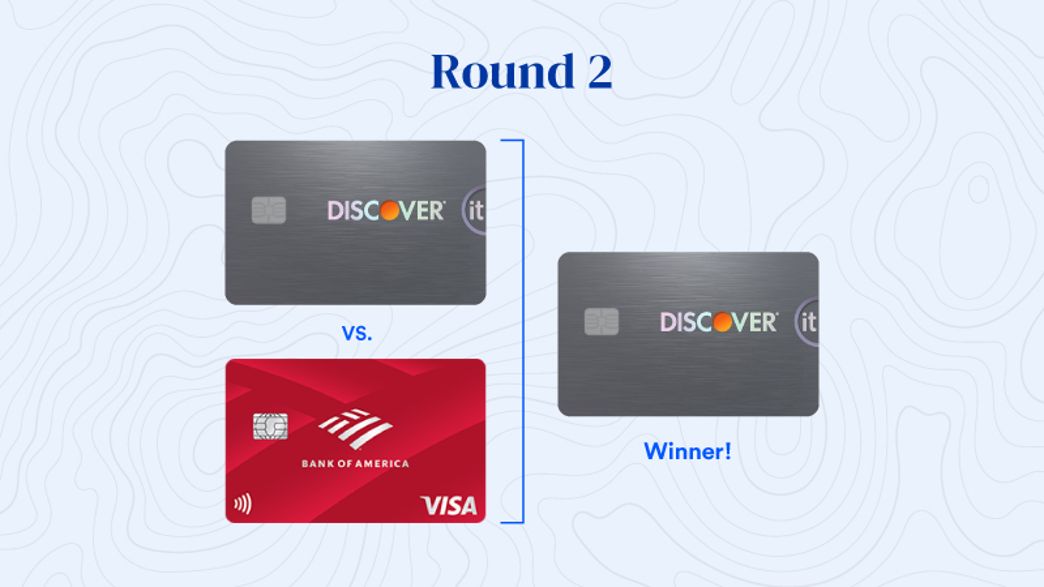
Final round: Discover it® Secured Credit Card vs. Amazon Prime Secured Card
We have made it to the final round of our battle with our two outstanding contenders: the Discover it® Secured Credit Card and the Amazon Prime Secured Card.
The Amazon Prime Secured Card has plenty to offer to cardholders who have a Prime membership. Amazon is convenient and offers just about any type of product. You can shop for groceries, clothing, household supplies, electronics and much more — and earn unlimited 2 percent cash back.
Still, the Amazon Prime Secured is a closed-loop retail card, and you won’t be able to use it anywhere outside of Amazon. Staying tied to one merchant is rarely a good idea, even a merchant as big as Amazon. You may end up missing out on better deals from other stores or find that a brand you love isn’t available on the site. Plus, you’ll miss out on earning rewards on common expenses like gas and dining.
The card also won’t help you create a relationship with any of the top card issuers. The Amazon Prime Secured Card is issued by Synchrony Bank, which is known for its co-branded store credits cards. The only way up from the Amazon Prime Secured Card is to the Amazon Prime Store Card, which offers a generous 5 percent cash back on Amazon purchases — but it also only works on Amazon.
The Discover it® Secured Credit Card, on the other hand, can be used at any merchant that accepts Discover. And as your credit improves, the issuer may be open to offering you an unsecured card, such as the Discover it® Cash Back, one of the best 5 percent rotating cash back cards, or the Discover it® Miles, a convenient flat-rate travel card. Considering all of this, it’s clear that victory belongs to the Discover it® Secured Credit Card once again.
Final-round winner: Discover it® Secured Credit Card
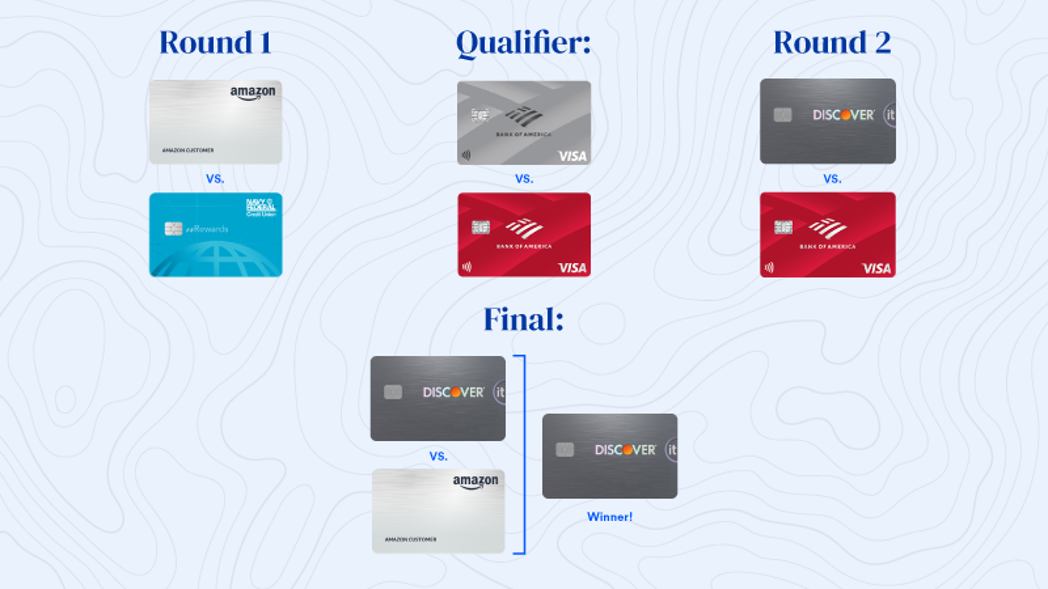
The bottom line
All of our competitors are outstanding secured credit cards with excellent rewards systems, no annual fees and credit-building tools. You can’t go wrong with adding any of them to your wallet if you’re looking to build credit. However, the Discover it® Secured Credit Card still holds first place thanks to its cash back rates, CashBack Match bonus, intro APR offer (which is rare for this class of cards) and opportunity to create a relationship with one of the top credit card issuers.
Whichever secured credit card you choose, make sure to use it as a tool to practice responsible card use and remember to be mindful about credit utilization (which is how much credit you’re using in relation to how much available credit you have). A low deposit may be attractive, but if you’re trying to keep your credit utilization ratio under 30 percent to help your credit, it may prove challenging. For example, if your credit limit is only $200, you’d always have to keep your balance under $60.
However, if you want to check out all of your credit card options, head over to CardMatch. With this handy tool, you can browse credit card offers matched to your credit profile. Checking for offers through CardMatch won’t hurt your credit and you’ll get offers you have a good chance of being approved for.
The Bank of America content in this post was last updated on Nov. 15, 2022.
*All information about the Amazon Store Card, Amazon Prime Store Card, Bank of America® Customized Cash Rewards Secured Credit Card and Bank of America® Unlimited Cash Rewards Secured credit card has been collected independently by Bankrate and has not been reviewed or approved by the issuer.

